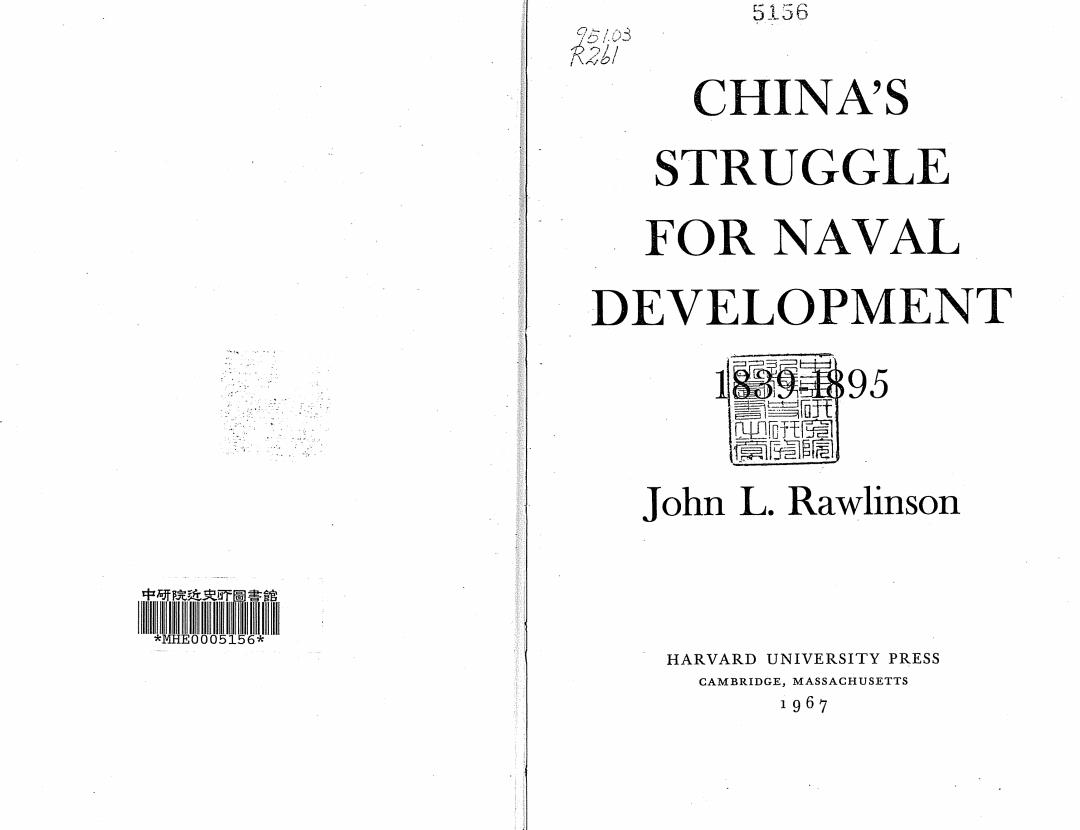
5156 CHINAS STRUGGLE FOR NAVAL DEVELOPMENT 880盡95 John L.Rawlinson HARVARD UNIVERSITY PRESS CAMBRIDGE,MASSACHUSETTS 1967
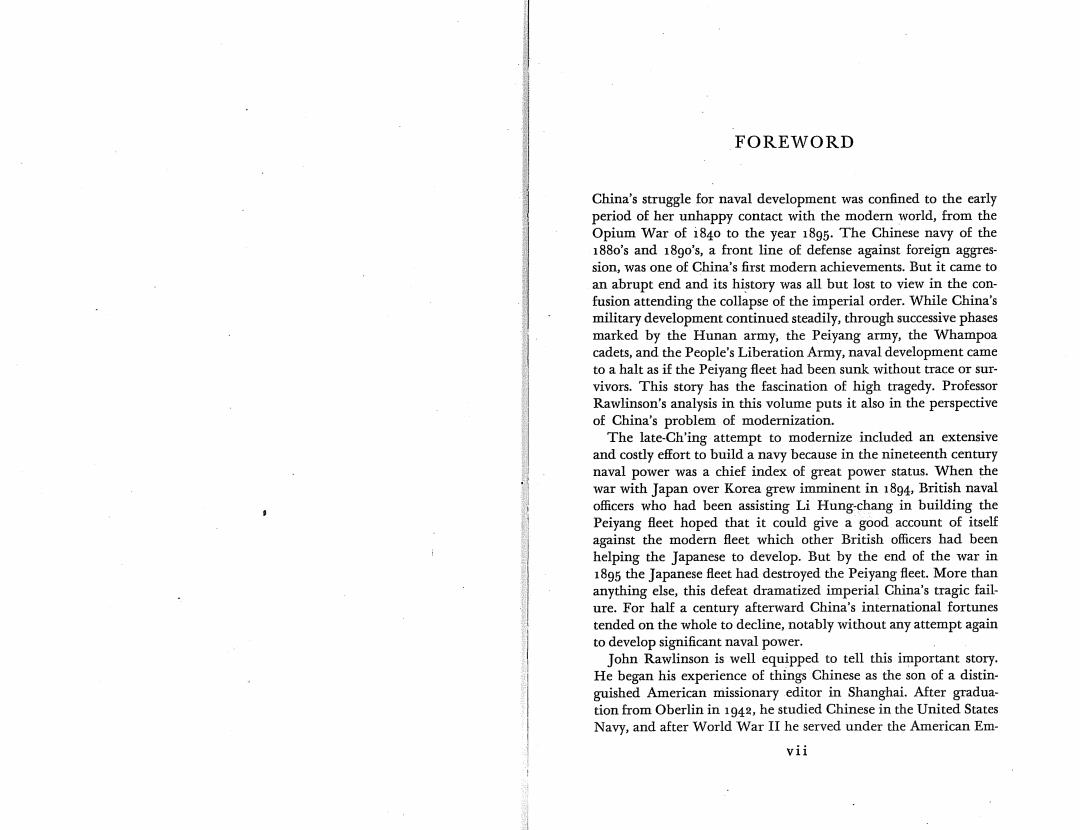
FOREWORD China's struggle for naval development was confined to the early period of her unhappy contact with the modern world,from the Opium War of i840 to the year 1895.The Chinese navy of the 188o's and 18go's,a front line of defense against foreign aggres- sion,was one of China's first modern achievements.But it came to an abrupt end and its history was all but lost to view in the con- fusion attending the collapse of the imperial order.While China's military development continued steadily,through successive phases marked by the Hunan army,the Peiyang army,the Whampoa cadets,and the People's Liberation Army,naval development came to a halt as if the Peiyang fleet had been sunk without trace or sur- vivors.This story has the fascination of high tragedy.Professor Rawlinson's analysis in this volume puts it also in the perspective of China's problem of modernization. The late-Ch'ing attempt to modernize included an extensive and costly effort to build a navy because in the nineteenth century naval power was a chief index of great power status.When the war with Japan over Korea grew imminent in 1894,British naval officers who had been assisting Li Hung-chang in building the Peiyang fleet hoped that it could give a good account of itself against the modern fleet which other British officers had been helping the Japanese to develop.But by the end of the war in 1895 the Japanese fleet had destroyed the Peiyang fleet.More than anything else,this defeat dramatized imperial China's tragic fail- ure.For half a century afterward China's international fortunes tended on the whole to decline,notably without any attempt again to develop significant naval power. John Rawlinson is well equipped to tell this important story. He began his experience of things Chinese as the son of a distin- guished American missionary editor in Shanghai.After gradua- tion from Oberlin in 1942,he studied Chinese in the United States Navy,and after World War II he served under the American Em- vii

CHINA'S STRUGGLE FOR NAVAL DEVELOPMENT bassy in China,becoming vice-consul at Tientsin.He then took his M.A.and Ph.D.at Harvard and is now associate professor of history and chairman of the Asian Studies Program at Hofstra University,Hempstead,Long Island. ACKNOWLEDGMENTS East Asian Research Center Harvard University In gathering the information for this book,I have tried insofar as possible to do my own translating from Chinese sources,but so great was the bulk of material that I have had to rely on expert assistance.In this connection,I deeply appreciate the careful work done by Immanuel C.Y.Hsui,Wai-kam Ho,Kwang-chih Chang, and John B.Liu.Mr.Te-kong Tong also made helpful sugges- tions.I am especially indebted to my friend Hsin-pao Chang, whose untimely death is a loss not only to me but to the commun- ity of scholars. At the East Asian Research Center,Kwang-Ching Liu,Eliza- beth M.Matheson,and Olive Holmes have made most valuable suggestions,Mrs.Matheson in particular helping me to overcome many stylistic grotesqueries.Over many years I have been indebted to John K.Fairbank,scholar,mentor,gentle but persistent critic, and friend. My departmental chairman,Dr.Gerrit P.Judd,painstakingly read the manuscript and excised many cumbersome passages to the profit of the reader. Thanks for further helpful suggestions made by Francelia Mason of Harvard University Press are also most appropriate,and they should include the work of Marjorie Lawlor,who typed the manuscript. Permission from Constable and Company Limited,London,to quote material from Pulling Strings in China by W.F.Tyler (1929)is gratefully acknowledged. Since this volume is dedicated to my wife,I need not reiterate here the great importance of her contribution. June 1,1966 J.L.R. Hofstra University viii ix
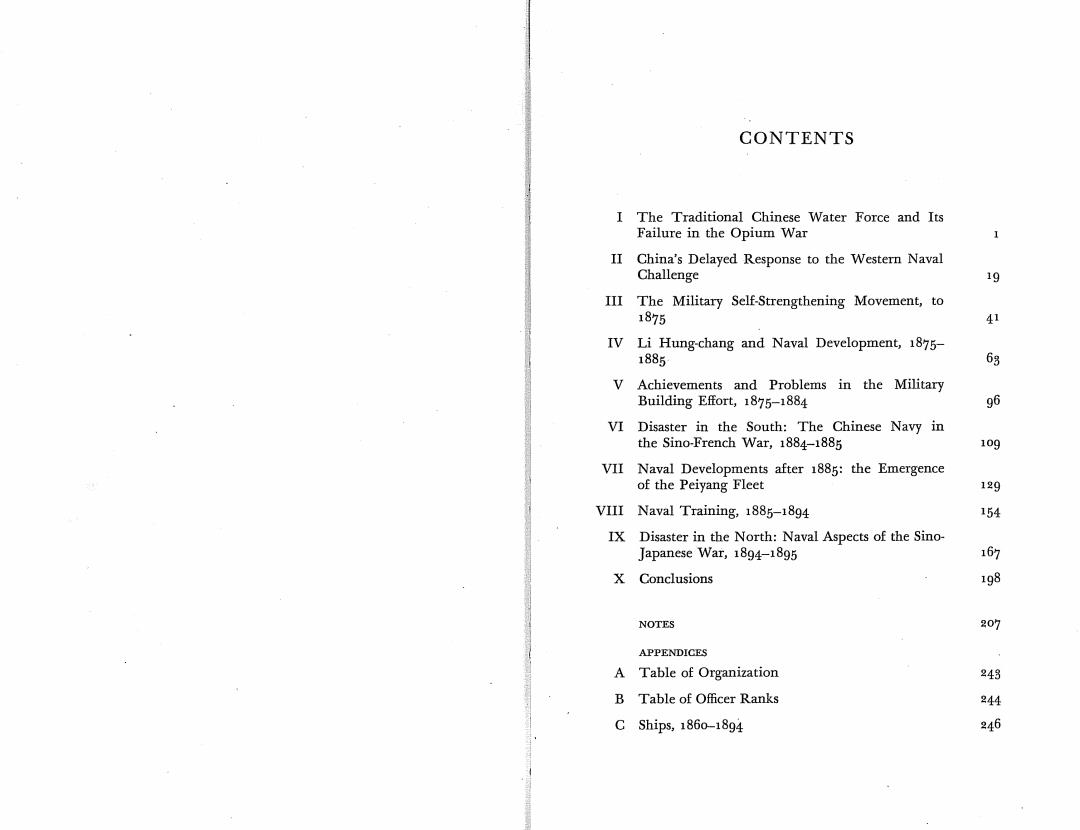
CONTENTS I The Traditional Chinese Water Force and Its Failure in the Opium War II China's Delayed Response to the Western Naval Challenge 和 III The Military Self-Strengthening Movement,to 1875 4 IV Li Hung-chang and Naval Development,1875- 1885 63 V Achievements and Problems in the Military Building Effort,1875-1884 96 VI Disaster in the South:The Chinese Navy in the Sino-French War,1884-1885 109 VII Naval Developments after 1885:the Emergence of the Peiyang Fleet 129 VIII Naval Training,1885-1894 154 IX Disaster in the North:Naval Aspects of the Sino- Japanese War,1894-1895 167 X Conclusions 198 NOTES 207 APPENDICES A Table of Organization 243 B Table of Officer Ranks 244 C Ships,1860-1894 246
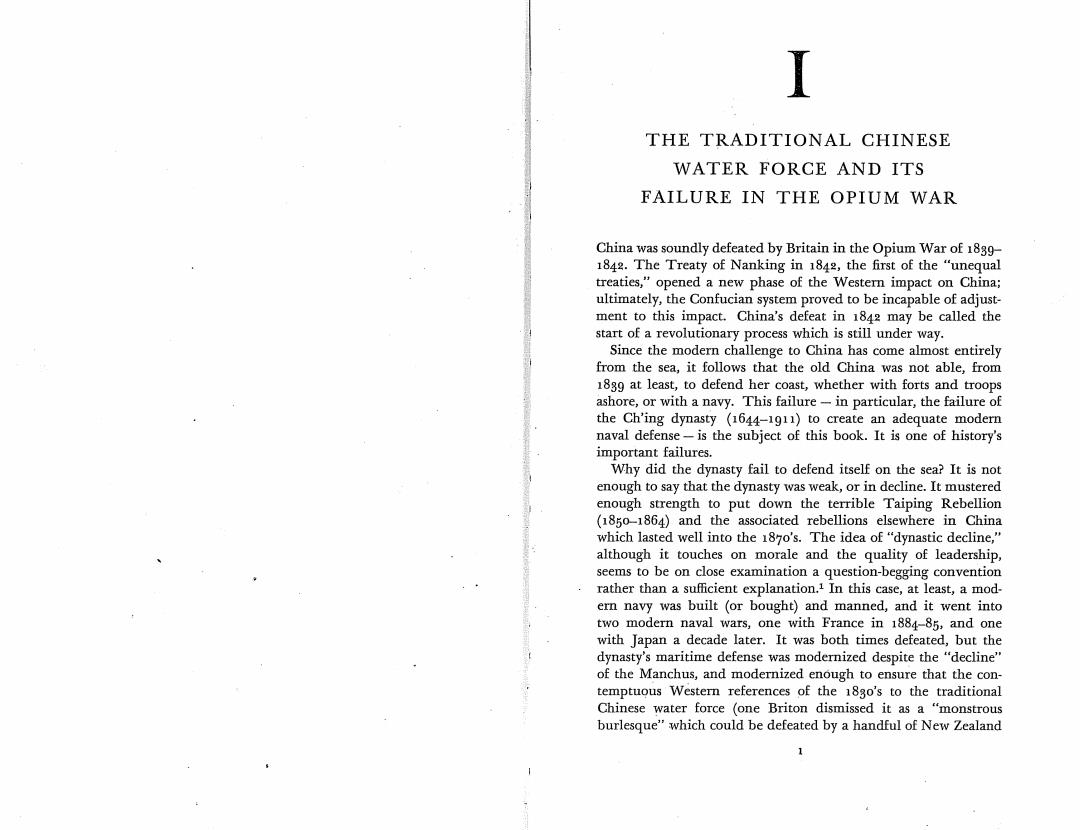
THE TRADITIONAL CHINESE WATER FORCE AND ITS FAILURE IN THE OPIUM WAR China was soundly defeated by Britain in the Opium War of 1839- 1842.The Treaty of Nanking in 1842,the first of the "unequal treaties,"opened a new phase of the Western impact on China; ultimately,the Confucian system proved to be incapable of adjust- ment to this impact.China's defeat in 1842 may be called the start of a revolutionary process which is still under way. Since the modern challenge to China has come almost entirely from the sea,it follows that the old China was not able,from 1839 at least,to defend her coast,whether with forts and troops ashore,or with a navy.This failure-in particular,the failure of the Ch'ing dynasty (1644-1911)to create an adequate modern naval defense-is the subject of this book.It is one of history's important failures. Why did the dynasty fail to defend itself on the sea?It is not enough to say that the dynasty was weak,or in decline.It mustered enough strength to put down the terrible Taiping Rebellion (1850-1864)and the associated rebellions elsewhere in China which lasted well into the 187o's.The idea of"dynastic decline," although it touches on morale and the quality of leadership, seems to be on close examination a question-begging convention rather than a sufficient explanation.In this case,at least,a mod- ern navy was built (or bought)and manned,and it went into two modern naval wars,one with France in 1884-85,and one with Japan a decade later.It was both times defeated,but the dynasty's maritime defense was modernized despite the "decline" of the Manchus,and modernized enough to ensure that the con- temptuous Western references of the 18go's to the traditional Chinese water force (one Briton dismissed it as a "monstrous burlesque"which could be defeated by a handful of New Zealand 1
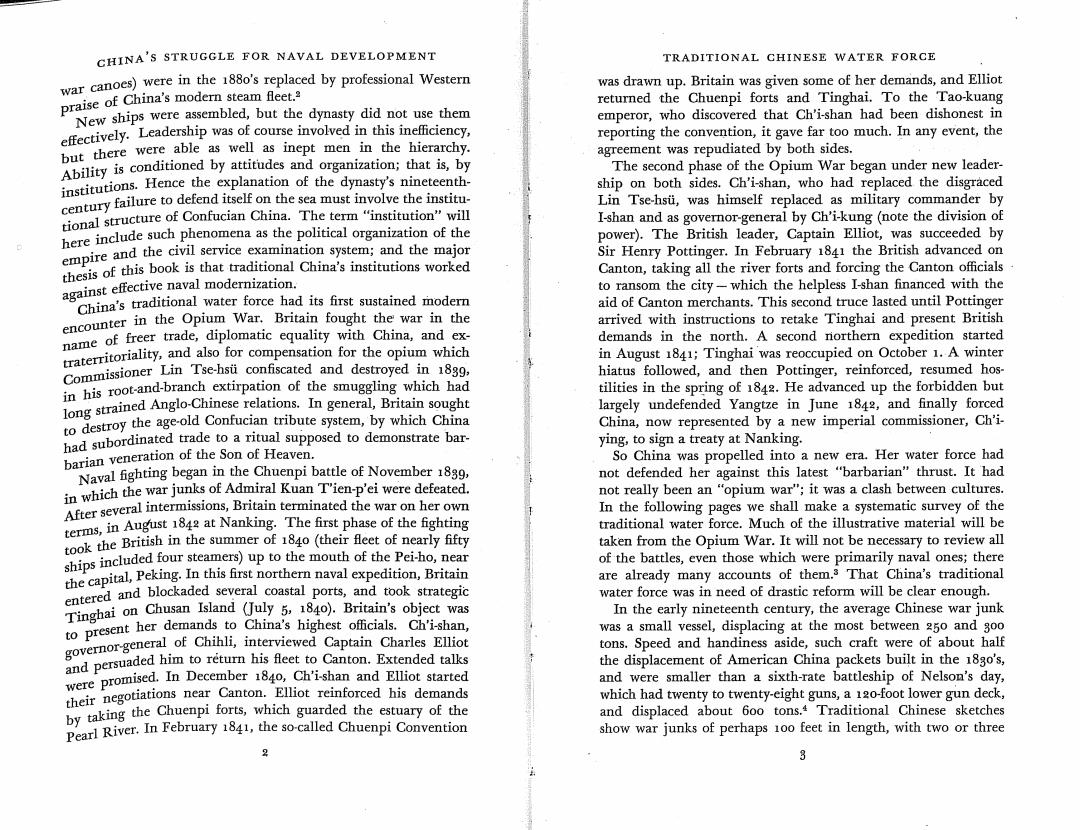
CHINA'S STRUGGLE FOR NAVAL DEVELOPMENT TRADITIONAL CHINESE WATER FORCE war cano)were in the'sreplaced by professional Westem was drawn up.Britain was given some of her demands,and Elliot praise of China's modern steam fleet. returned the Chuenpi forts and Tinghai.To the Tao-kuang New ships were assembled,but the dynasty did not use them emperor,who discovered that Ch'i-shan had been dishonest in fectively.Leadership was of course involved in this inefficiency, reporting the convention,it gave far too much.In any event,the but there were able as well as inept men in the hierarchy. agreement was repudiated by both sides. Ability is conditioned by attitudes and organiation;that is by The second phase of the Opium War began under new leader- institutions.Hence the explanation of the dynasty's nineteenth ship on both sides.Ch'i-shan,who had replaced the disgraced century failure to defend itseon theseausnove the Lin Tse-hsui,was himself replaced as military commander by tional structure of Confucian China.The term"institutionwill I-shan and as governor-general by Ch'i-kung(note the division of here include such phenomena as the political organization of the power).The British leader,Captain Elliot,was succeeded by empire and the civil service xamination system:and the Sir Henry Pottinger.In February 1841 the British advanced on thesis of this book is that traditional Chinas instittions workd Canton,taking all the river forts and forcing the Canton officials against effective naval modernization. to ransom the city-which the helpless I-shan financed with the China's traditional water force had its first sustained modern aid of Canton merchants.This second truce lasted until Pottinger encounter in the Opium War.Britain fought the war in the arrived with instructions to retake Tinghai and present British name of freer trade,diplomatic equality with China,and x demands in the north.A second niorthern expedition started traterritoriality,and also for compensation for the opium which in August 1841;Tinghai was reoccupied on October 1.A winter Commissioner Lin Tsehs confiscated and destroyed in. hiatus followed,and then Pottinger,reinforced,resumed hos- in his root-and-branch extirpation of the smuggling which had tilities in the spring of 1842.He advanced up the forbidden but ongstrained Anglo-Chinese relations I geera Britain souh largely undefended Yangtze in June 1842,and finally forced to destroy theageod Confucian tribute ystem,by which Chn China,now represented by a new imperial commissioner,Ch'i- had subordinated trade to a ritual supposed to demonstrate bar ying,to sign a treaty at Nanking. barian veneration of the Son of Heaven. So China was propelled into a new era.Her water force had Naval fighting began in the Chuenpi battle of November189. not defended her against this latest "barbarian"thrust.It had in which the war junks of Admiral Kuan Tien-p'ei were defeated. not really been an "opium war";it was a clash between cultures. After several inteBritain terminated the warnherown In the following pages we shall make a systematic survey of the terms,in August at Nanking.The first phase of the fighting traditional water force.Much of the illustrative material will be took the British in theummrof(their fleet of nearlyfft taken from the Opium War.It will not be necessary to review all ships incuded four steamers)uptothe mouth of the Pei-ho,near of the battles,even those which were primarily naval ones;there the capital,Peking.In thisfirstte naval expedition,Britain are already many accounts of them.s That China's traditional entered and blockaded several coastal ports,and took strategic water force was in need of drastic reform will be clear enough. Tinghai on Chusan Island (July 5,1840).Britain's object was In the early nineteenth century,the average Chinese war junk to present her demands to China's highest officials.Ch'i-shan, was a small vessel,displacing at the most between 250 and 300 gov of Chhli,nterviewed Captain Charleso tons.Speed and handiness aside,such craft were of about half and persuaded him to his fleet toCanton.Extended talks the displacement of American China packets built in the 183o's, were promised.In December Ch'i-shan and Elliot started and were smaller than a sixth-rate battleship of Nelson's day, their negotiations near Canton.Elliot reinforced his demands which had twenty to twenty-eight guns,a 12o-foot lower gun deck, by taking the Chuenpi forts,which guarded the estuary ofthe and displaced about 6oo tons.4 Traditional Chinese sketches Pearl River.In February the socalled Chuenpi Convention show war junks of perhaps 1oo feet in length,with two or three 3
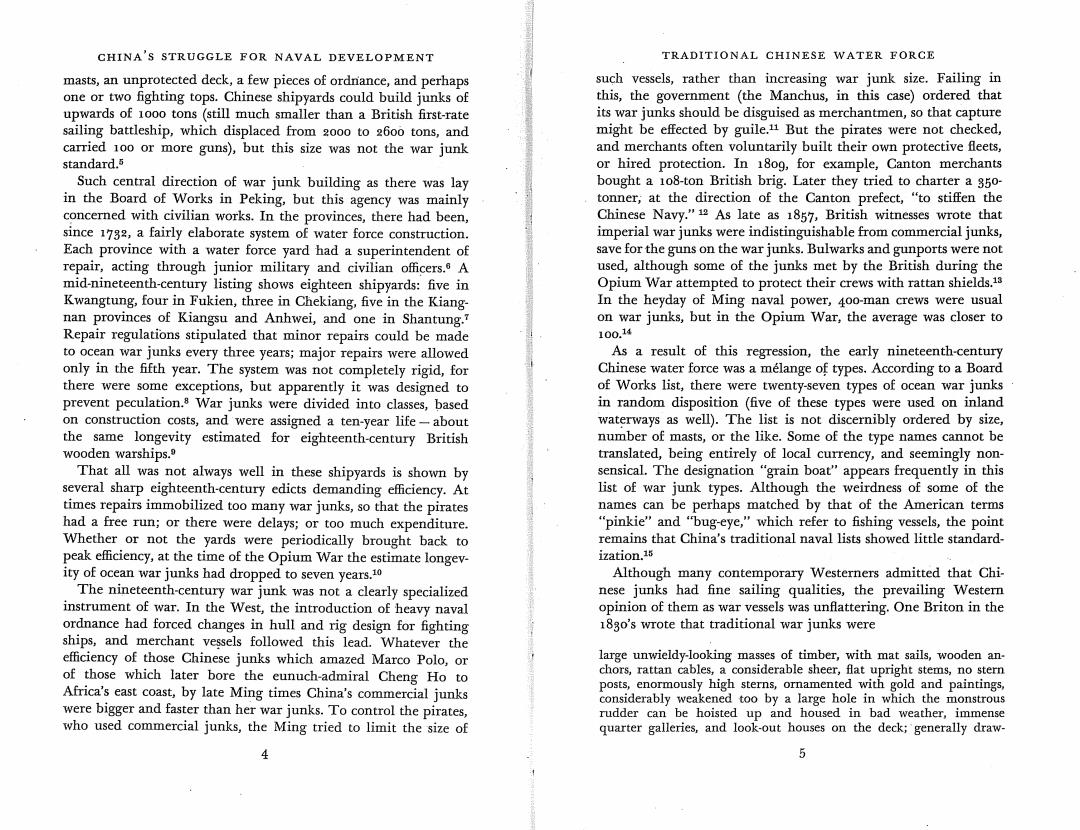
CHINA'S STRUGGLE FOR NAVAL DEVELOPMENT TRADITIONAL CHINESE WATER FORCE masts,an unprotected deck,a few pieces of ordnance,and perhaps such vessels,rather than increasing war junk size.Failing in one or two fighting tops.Chinese shipyards could build junks of this,the government (the Manchus,in this case)ordered that upwards of 1o0o tons(still much smaller than a British first-rate its war junks should be disguised as merchantmen,so that capture sailing battleship,which displaced from zo00 to 2600 tons,and might be effected by guile.11 But the pirates were not checked, carried 1oo or more guns),but this size was not the war junk and merchants often voluntarily built their own protective fleets, standard.5 or hired protection.In 1809,for example,Canton merchants Such central direction of war junk building as there was lay bought a 108-ton British brig.Later they tried to charter a 850- in the Board of Works in Peking,but this agency was mainly tonner,at the direction of the Canton prefect,"to stiffen the concerned with civilian works.In the provinces,there had been, Chinese Navy."As late as 1857,British witnesses wrote that since 1732,a fairly elaborate system of water force construction. imperial war junks were indistinguishable from commercial junks, Each province with a water force yard had a superintendent of save for the guns on the war junks.Bulwarks and gunports were not repair,acting through junior military and civilian officers.o A used,although some of the junks met by the British during the mid-nineteenth-century listing shows eighteen shipyards:five in Opium War attempted to protect their crews with rattan shields.15 Kwangtung,four in Fukien,three in Chekiang,five in the Kiang- In the heyday of Ming naval power,4oo-man crews were usual nan provinces of Kiangsu and Anhwei,and one in Shantung.7 on war junks,but in the Opium War,the average was closer to Repair regulations stipulated that minor repairs could be made 100.14 to ocean war junks every three years;major repairs were allowed As a result of this regression,the early nineteenth-century only in the fifth year.The system was not completely rigid,for Chinese water force was a melange of types.According to a Board there were some exceptions,but apparently it was designed to of Works list,there were twenty-seven types of ocean war junks prevent peculation.War junks were divided into classes,based in random disposition (five of these types were used on inland on construction costs,and were assigned a ten-year life-about waterways as well).The list is not discernibly ordered by size, the same longevity estimated for eighteenth-century British number of masts,or the like.Some of the type names cannot be wooden warships. translated,being entirely of local currency,and seemingly non- That all was not always well in these shipyards is shown by sensical.The designation "grain boat"appears frequently in this several sharp eighteenth-century edicts demanding efficiency.At list of war junk types.Although the weirdness of some of the times repairs immobilized too many war junks,so that the pirates names can be perhaps matched by that of the American terms had a free run;or there were delays;or too much expenditure. "pinkie"and "bug-eye,"which refer to fishing vessels,the point Whether or not the yards were periodically brought back to remains that China's traditional naval lists showed little standard- peak efficiency,at the time of the Opium War the estimate longev- ization.15 ity of ocean war junks had dropped to seven years.10 Although many contemporary Westerners admitted that Chi- The nineteenth-century war junk was not a clearly specialized nese junks had fine sailing qualities,the prevailing Western instrument of war.In the West,the introduction of heavy naval opinion of them as war vessels was unflattering.One Briton in the ordnance had forced changes in hull and rig design for fighting 183o's wrote that traditional war junks were ships,and merchant vessels followed this lead.Whatever the efficiency of those Chinese junks which amazed Marco Polo,or large unwieldy-looking masses of timber,with mat sails,wooden an- of those which later bore the eunuch-admiral Cheng Ho to chors,rattan cables,a considerable sheer,flat upright stems,no stern Africa's east coast,by late Ming times China's commercial junks posts,enormously high sterns,ornamented with gold and paintings, were bigger and faster than her war junks.To control the pirates, considerably weakened too by a large hole in which the monstrous rudder can be hoisted up and housed in bad weather,immense who used commercial junks,the Ming tried to limit the size of quarter galleries,and look-out houses on the deck;generally draw- 4 5
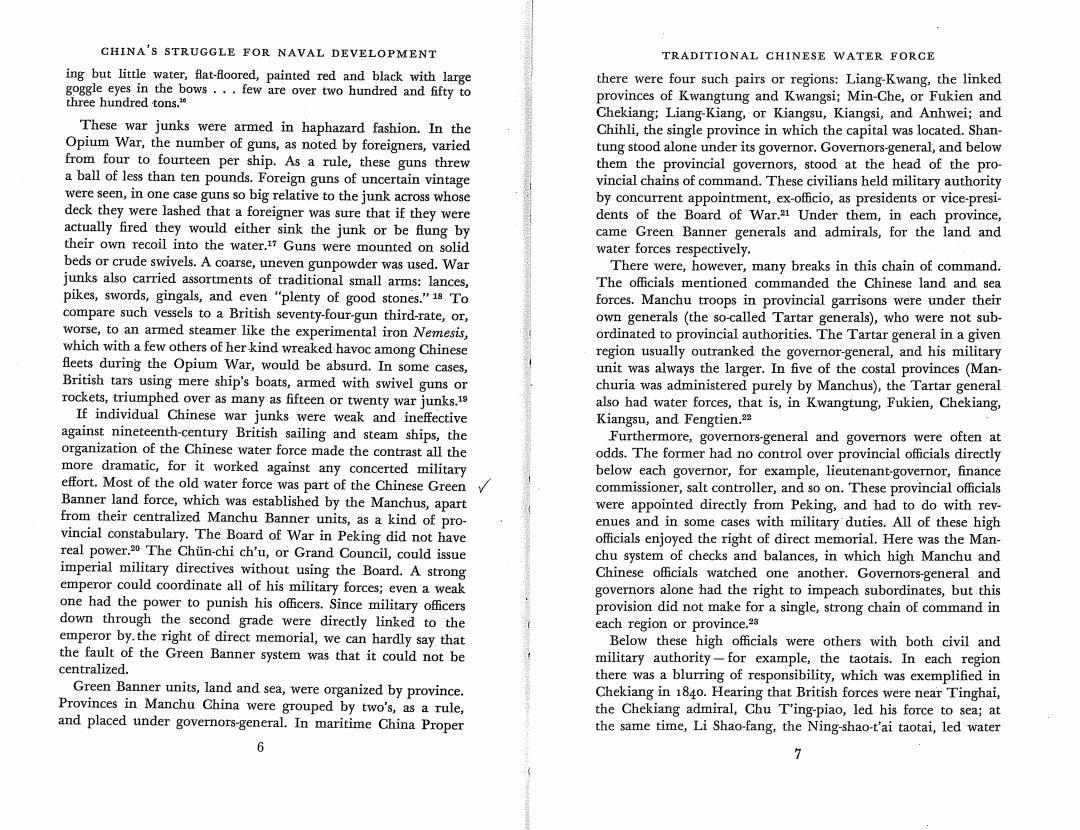
CHINA'S STRUGGLE FOR NAVAL DEVELOPMENT TRADITIONAL CHINESE WATER FORCE ing but little water,fat-floored,painted red and black with large there were four such pairs or regions:Liang-Kwang,the linked goggle eyes in the bows...few are over two hundred and fifty to three hundred tons."0 provinces of Kwangtung and Kwangsi;Min-Che,or Fukien and Chekiang;Liang-Kiang,or Kiangsu,Kiangsi,and Anhwei;and These war junks were armed in haphazard fashion.In the Chihli,the single province in which the capital was located.Shan- Opium War,the number of guns,as noted by foreigners,varied tung stood alone under its governor.Governors-general,and below from four to fourteen per ship.As.a rule,these guns threw them the provincial governors,stood at the head of the pro- a ball of less than ten pounds.Foreign guns of uncertain vintage vincial chains of command.These civilians held military authority were seen,in one case guns so big relative to the junk across whose by concurrent appointment,ex-officio,as presidents or vice-presi- deck they were lashed that a foreigner was sure that if they were dents of the Board of War.21 Under them,in each province, actually fired they would either sink the junk or be flung by came Green Banner generals and admirals,for the land and their own recoil into the water.17 Guns were mounted on solid water forces respectively. beds or crude swivels.A coarse,uneven gunpowder was used.War There were,however,many breaks in this chain of command. junks also carried assortments of traditional small arms:lances, The officials mentioned commanded the Chinese land and sea pikes,swords,gingals,and even "plenty of good stones."is To forces.Manchu troops in provincial garrisons were under their compare such vessels to a British seventy-four-gun third-rate,or, own generals(the so-called Tartar generals),who were not sub- worse,to an armed steamer like the experimental iron Nemesis, ordinated to provincial authorities.The Tartar general in a given which with a few others of her kind wreaked havoc among Chinese region usually outranked the governor-general,and his military fleets during the Opium War,would be absurd.In some cases, unit was always the larger.In five of the costal provinces (Man- British tars using mere ship's boats,armed with swivel guns or churia was administered purely by Manchus),the Tartar general rockets,triumphed over as many as fifteen or twenty war junks.19 also had water forces,that is,in Kwangtung,Fukien,Chekiang, If individual Chinese war junks were weak and ineffective Kiangsu,and Fengtien.22 against nineteenth-century British sailing and steam ships,the Furthermore,governors-general and governors were often at organization of the Chinese water force made the contrast all the odds.The former had no control over provincial officials directly more dramatic,for it worked against any concerted military below each governor,for example,lieutenant-governor,finance effort.Most of the old water force was part of the Chinese Green commissioner,salt controller,and so on.These provincial officials Banner land force,which was established by the Manchus,apart were appointed directly from Peking,and had to do with rev- from their centralized Manchu Banner units,as a kind of pro- enues and in some cases with military duties.All of these high vincial constabulary.The Board of War in Peking did not have officials enjoyed the right of direct memorial.Here was the Man- real power.20 The Chuin-chi ch'u,or Grand Council,could issue chu system of checks and balances,in which high Manchu and imperial military directives without using the Board.A strong Chinese officials watched one another.Governors-general and emperor could coordinate all of his military forces;even a weak governors alone had the right to impeach subordinates,but this one had the power to punish his officers.Since military officers provision did not make for a single,strong chain of command in down through the second grade were directly linked to the each region or province.28 emperor by.the right of direct memorial,we can hardly say that Below these high officials were others with both civil and the fault of the Green Banner system was that it could not be military authority-for example,the taotais.In each region centralized. there was a blurring of responsibility,which was exemplified in Green Banner units,land and sea,were organized by province. Chekiang in 1840.Hearing that British forces were near Tinghai, Provinces in Manchu China were grouped by two's,as a rule, the Chekiang admiral,Chu Ting-piao,led his force to sea;at and placed under governors-general.In maritime China Proper the same time,Li Shao-fang,the Ning-shao-t'ai taotai,led water 6 7

CHINA'S STRUGGLE FOR NAVAL DEVELOPMENT TRADITIONAL CHINESE WATER FORCE forces to Chenhai;a little later,the Ningpo prefect (chih-fu) Officer recruits came from the civil service,the ranks of heredi- was ordered to build a boom of boats and chains to keep the tary nobles,officers'sons,the land military,successful candidates enemy out.24 In addition,each of the highest officials had his in the military examination system,and the rank and file.Some own command.In the coastal Manchu and Green Banner estab- water force officers were ex-pirates who had been lured from lishments,there were twenty-four of these commands,not uni- their old calling by the offer of rank.2 There were minute reg- formly established:the distribution was such that in Kwangtung ulations governing promotion,in which the accumulation of and Fukien each there were five commands,those of the gov- seniority and merit were nominally basic.However,the emperor ernor-general,governor,admiral,general,and Tartar general, could set aside the regulations,and not all officers were experts. but in Chihli only two,for the governor-general and admiral.25 Imperial interference was most notable in the higher ranks; These so-called "direct commands"were nominally of brigade below junior lieutenant,provincial authorities had the say, strength (those under the military men were larger than those for officers and enlisted men.They preferred men of the sea, under the civilian officials),and were largely independent.Other fishermen or ex-pirates,or men of martial accomplishment as Green Banner forces in each province not in direct commands shown in the land military.Fukien was a favored source of sea- were "indirectly"commanded by the named officials.Some brig- faring men;it was said that the Fukien pirates included the adier-generals had more strength than their superiors in this "flower"of the nation,whereas the imperial fleet had chiefly the system;some district civilian officials with military concurrencies “dregs..”30 could be nearly independent,acting only in response to a"direct" There were detailed provisions for rewards,honors,and super- command;in some cases,local officers had to answer to three or annuation.Green Banner punishments were drawn from a basic four chiefs,as did the senior post captain of a water force unit code dating from 1781,which had been slightly amended.Officers on Formosa who corresponded with the Board of War about and men were not subject to the same penalties.For the former, the Formosan aborigines,and was also beholden to the Tartar a greater emphasis was laid on corrective humiliation (one general and the admiral at Foochow,as well as to the Min-Che Westerner in the 18go's noticed a water force officer near Shanghai governor-general.26 with an arrow thrust through his ear,captioned with a statement In this elaborate system,the Green Banner table of organiza- of the culprit's disregard of a military law),a which included tion for land and water forces (brigade,regiment,battalion, degrading them but keeping them on at their posts.For coward- squadron,and post)almost disappears from view.Yet the disar- ice or treason,the code uniformly prescribed death.The opera- ray was not a function of dynastic decline.The system had been tion of the code depended on the will of the emperor.There largely created by the K'ang-hsi Emperor,to ensure stability.27 was no provision for the investigation of a charge by a military Comment on the personnel system of the traditional water court,and the criteria were ultimately moral,so that ultimate force must be based largely on material directly pertinent to the judgment could be exercised only by the Son of Heaven.Un- parent Green Banner land force.There were nine Green Banner certainty about condignity of punishment,or the imperial mood, officer ranks in each of the provincial forces.The water force must have been familiar to men in action,certainly to the higher designations,in approximate English equivalent,were admiral, officers.32 senior post captain,junior post captain,commander,lieutenant Most training took place in prescribed coastal patrols.These commanding,senior lieutenant,junior lieutenant,sub-lieutenant, patrols were not always properly made,for an edict of 1806 re- and ensign.These nine ranks corresponded to the nine basic ferred to standing orders about coastal training and warned civilian official grades,save that admiral did not rank in the top officers to select good men,and to go to sea themselves.Just before half of the opposite'civilian grade (each of these being divided the Opium War,annual examinations were specified for water into an upper and lower half),but only in the lower.Military force officers,who again were ordered to go to sea in person.as service did not have the prestige of the civil service.28 In 1840,an imperial commissioner expressed concern about per- 8 0
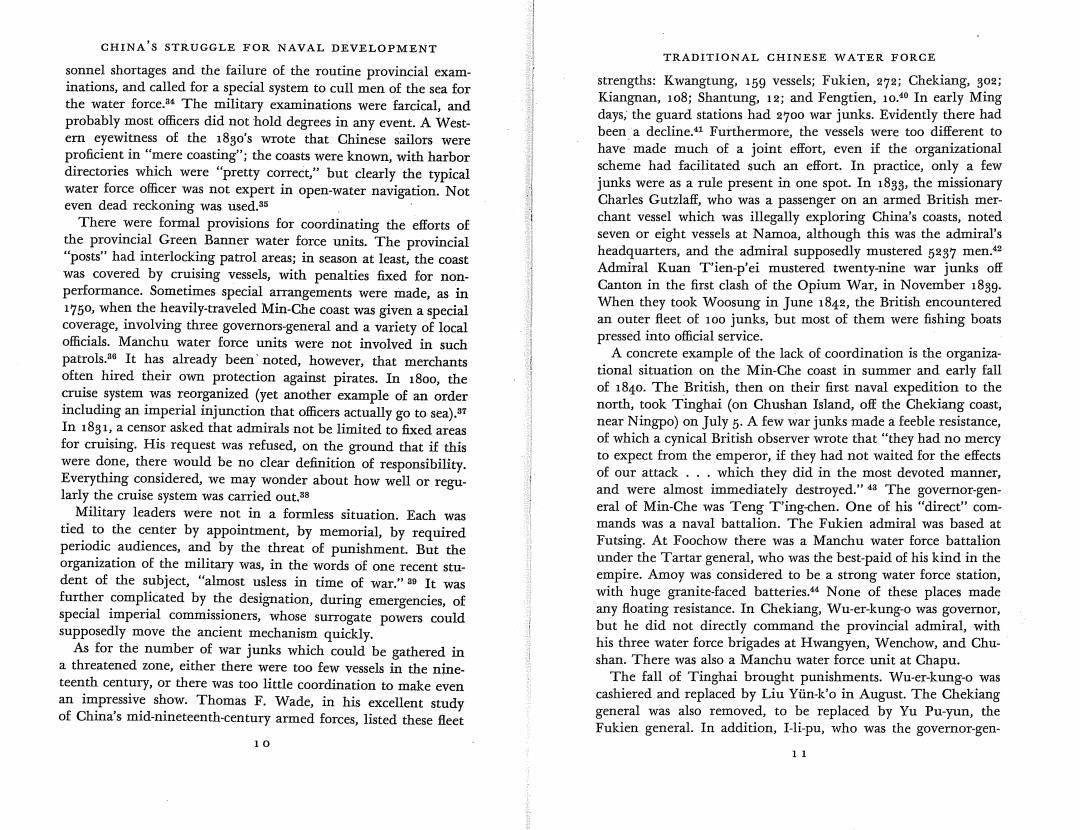
CHINA'S STRUGGLE FOR NAVAL DEVELOPMENT TRADITIONAL CHINESE WATER FORCE sonnel shortages and the failure of the routine provincial exam- inations,and called for a special system to cull men of the sea for strengths:Kwangtung,159 vessels;Fukien,272;Chekiang,302; the water force.The military examinations were farcical,and Kiangnan,108;Shantung,12;and Fengtien,10.40 In early Ming probably most officers did not hold degrees in any event.A West- days,the guard stations had 2700 war junks.Evidently there had ern eyewitness of the 18go's wrote that Chinese sailors were been a decline.41 Furthermore,the vessels were too different to proficient in"mere coasting";the coasts were known,with harbor have made much of a joint effort,even if the organizational directories which were "pretty correct,"but clearly the typical scheme had facilitated such an effort.In practice,only a few water force officer was not expert in open-water navigation.Not junks were as a rule present in one spot.In 18g3,the missionary even dead reckoning was used.35 Charles Gutzlaff,who was a passenger on an armed British mer- There were formal provisions for coordinating the efforts of chant vessel which was illegally exploring China's coasts,noted the provincial Green Banner water force units.The provincial seven or eight vessels at Namoa,although this was the admiral's "posts"had interlocking patrol areas;in season at least,the coast headquarters,and the admiral supposedly mustered 5237 men.42 was covered by cruising vessels,with penalties fixed for non- Admiral Kuan Tien-p'ei mustered twenty-nine war junks off performance.Sometimes special arrangements were made,as in Canton in the first clash of the Opium War,in November 1839. 1750,when the heavily-traveled Min-Che coast was given a special When they took Woosung in June 1842,the British encountered coverage,involving three governors-general and a variety of local an outer fleet of 1o0 junks,but most of them were fishing boats officials.Manchu water force units were not involved in such pressed into official service. patrols.3 It has already been'noted,however,that merchants A concrete example of the lack of coordination is the organiza- often hired their own protection against pirates.In 1800,the tional situation on the Min-Che coast in summer and early fall cruise system was reorganized (yet another example of an order of 1840.The British,then on their first naval expedition to the including an imperial injunction that officers actually go to sea).7 north,took Tinghai (on Chushan Island,off the Chekiang coast, In 18g1,a censor asked that admirals not be limited to fixed areas near Ningpo)on July 5.A few war junks made a feeble resistance, for cruising.His request was refused,on the ground that if this of which a cynical British observer wrote that"they had no mercy were done,there would be no clear definition of responsibility. to expect from the emperor,if they had not waited for the effects Everything considered,we may wonder about how well or regu- of our attack ..which they did in the most devoted manner, larly the cruise system was carried out.38 and were almost immediately destroyed."4a The governor-gen- Military leaders were not in a formless situation.Each was eral of Min-Che was Teng T'ing-chen.One of his "direct"com- tied to the center by appointment,by memorial,by required mands was a naval battalion.The Fukien admiral was based at periodic audiences,and by the threat of punishment.But the Futsing.At Foochow there was a Manchu water force battalion organization of the military was,in the words of one recent stu- under the Tartar general,who was the best-paid of his kind in the dent of the subject,"almost usless in time of war."a It was empire.Amoy was considered to be a strong water force station, further complicated by the designation,during emergencies,of with huge granite-faced batteries.44 None of these places made special imperial commissioners,whose surrogate powers could any floating resistance.In Chekiang,Wu-er-kung-o was governor, supposedly move the ancient mechanism quickly. but he did not directly command the provincial admiral,with As for the number of war junks which could be gathered in his three water force brigades at Hwangyen,Wenchow,and Chu- a threatened zone,either there were too few vessels in the nine- shan.There was also a Manchu water force unit at Chapu. teenth century,or there was too little coordination to make even The fall of Tinghai brought punishments.Wu-er-kung-o was an impressive show.Thomas F.Wade,in his excellent study cashiered and replaced by Liu Yun-k'o in August.The Chekiang of China's mid-nineteenth-century armed forces,listed these fleet general was also removed,to be replaced by Yu Pu-yun,the Fukien general.In addition,I-li-pu,who was the governor-gen- 10 11